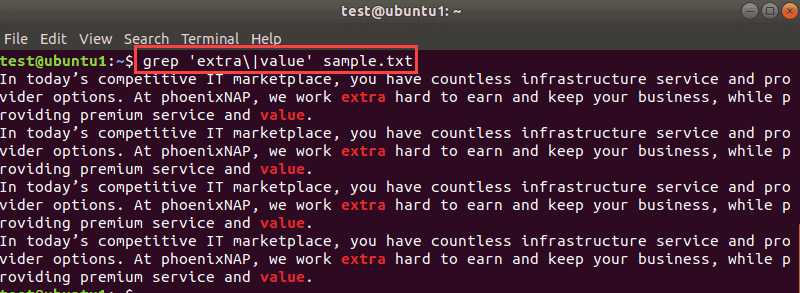

- #Unix search for text in files how to#
- #Unix search for text in files update#
- #Unix search for text in files windows#
This is because /l*/ means ‘ match letter l zero or more times‘, so /l*c/ means ‘ match letter c preceded by zero or more occurrences of letter l‘, but any line that contains the letter c in it also contain zero or more letters l in front of it - the key to understanding this is “ ZERO or more times“.ĬONCLUSION: In REGEXP the asterisk symbol (*) does not mean the same thing as in Microsoft Windows and DOS/CMD file-name matching, it does not match any character (as this tutorial erroneously suggests), it matches the preceding character ZERO or more times. The above will match all lines that contain the letter ‘c’ regardless whether they contain the letter ‘l’ or not. The example below prints all the lines in the file /etc/hosts since no pattern is given. In the following examples, we shall focus on the meta characters that we discussed above under the features of awk. The 'script' is in the form '/pattern/ action' where pattern is a regular expression and the action is what awk will do when it finds the given pattern in a line. This is repeated on all the lines in the file. It works by reading a given line in the file, makes a copy of the line and then executes the script on the line. Where 'script' is a set of commands that are understood by awk and are execute on file, filename. The general syntax of awk is: # awk 'script' filename But for the scope of this guide to using awk, we shall cover it as a simple command line filtering tool. You can think of awk as a programming language of its own. In order to filter text, one has to use a text filtering tool such as awk. ^ it matches the beginning of a line in a file.it matches any one of the characters specified in character(s), one can also use a hyphen (-) to mean a range of characters such as, , and so on.(*) it matches zero or more existences of the immediate character preceding it.(.) it matches any single character except a newline.Meta characters that are expanded to ordinary characters, they include:.Ordinary characters such as space, underscore(_), A-Z, a-z, 0-9.One of the most important things about regular expressions is that they allow you to filter the output of a command or file, edit a section of a text or configuration file and so on. Read Also: 10 Useful Linux Chaining Operators with Practical Examples What are Regular Expressions?Ī regular expression can be defined as a strings that represent several sequence of characters. This is where using regular expressions comes in handy. In a previous version of himself he wrote books on technology.Ĭontent is licensed under a Creative Commons Attribution-NonCommercial-ShareAlike 4.0 International (CC BY-NC-SA 4.When we run certain commands in Unix/Linux to read or edit text from a string or file, we most times try to filter output to a given section of interest. He is interested in people, music, food and writing. You can edit it here and send me a pull request.
#Unix search for text in files update#
Have an update or suggestion for this article? Some examples of using UNIX find command.Find Command in Unix and Linux Examples.A collection of Unix/Linux find command examples.To be prompted to confirm deletion combine -exec with rm -i. If you require following all symbolic links, use -R instead of -r. r stands for recursive, reading all the files in the directory and its subdirectories. This includes strings like texting for example, because it contains our search pattern, text.

This will delete the file with no undo so be careful. This lists all the files in the current folder and subfolders containing text. To find and delete a file pass the -delete option to find. The file foo.txt can be located with the find by using the -name option. Suppose the following directory structure exists shown here as the output of the tree command. To find a single file by name pass the -name option to find along with the name of the file you are looking for. By using the - exec other UNIX commands can be executed on files or folders found. It supports searching by file, folder, name, creation date, modification date, owner and permissions. It can be used to find files and directories and perform subsequent operations on them. The find command in UNIX is a command line utility for walking a file hierarchy.
#Unix search for text in files how to#
How to search for text within multiple files.How to find and replace in a range of files.Examples of finding a file by name, finding and deleting a file, finding a directory and searching by modification time and permissions.Įstimated reading time: 3 minutes Table of contents In This tutorial we will look at some useful Unix grep. Last updated Monday, Linux and Unix find command tutorial with examples Tutorial on using find, a UNIX and Linux command for walking a file hierarchy. Unix grep command search text patterns from files and return the matching lines and the filename. Linux and Unix find command tutorial with examples | George Ornbo


 0 kommentar(er)
0 kommentar(er)
